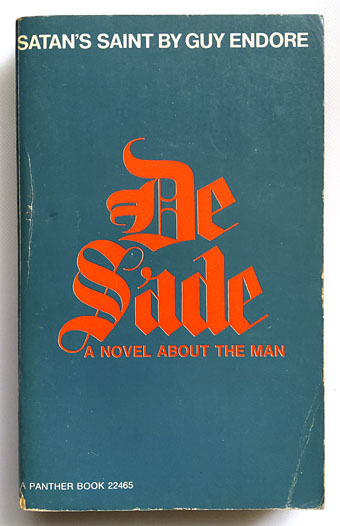
Digging in a box for an errant paperback turned up this volume which I’ve owned for years but never read. Having recently watched Jan Svankmajer’s Lunacy, which has a Sade-like character among its cast, I thought I should give it a proper look. Sade’s irreligious and libertine philosophies haunt the Surrealist world, hence Svankmajer’s interest, Jean Benoît’s performance art and so on. Surrealism didn’t have any saints but it did maintain a pantheon of precursors, with Sade accorded the status of “Genius of Wheels” (ie: revolution) in the Surrealist deck of playing cards.
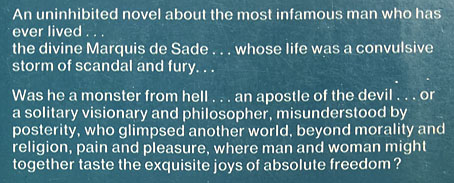
Guy Endore (1900–1970) wasn’t a genius, a satanist or a saint but he was an interesting character, an American writer best known today for The Werewolf of Paris, another novel I own and have yet to read. He was a vegetarian and a socialist at a time when both these pursuits were regarded with suspicion or outright hostility (his Communist sympathies later caused him to be placed on the Hollywood blacklist). He wrote a great deal of historical fiction—in addition to Satan’s Saint there are novels based on the lives of Casanova, Voltaire and Shakespeare. And his Hollywood credits include work on scripts for Tod Browning (Mark of the Vampire, The Devil-Doll), writing the source novel (Methinks the Lady) that became Otto Preminger’s psychological film noir, Whirlpool, and, with John Balderstone, adapting Maurice Renard’s The Hands of Orlac into the screenplay that became Peter Lorre’s Hollywood debut, Mad Love. The latter is a great film that I’d love to see again. Satan’s Saint was first published in 1965. This Panther edition appeared in 1967. Now I just have to find the time to read it…
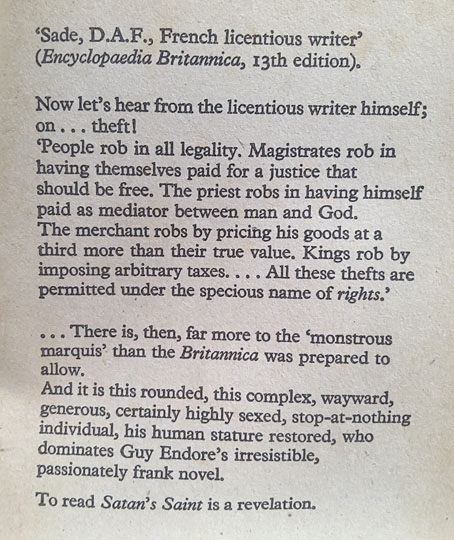
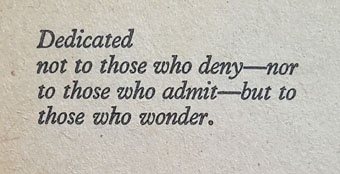
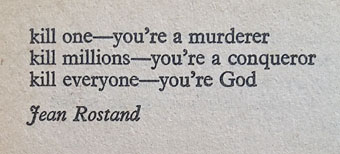
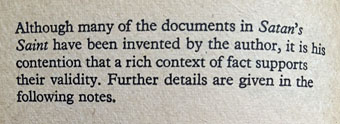
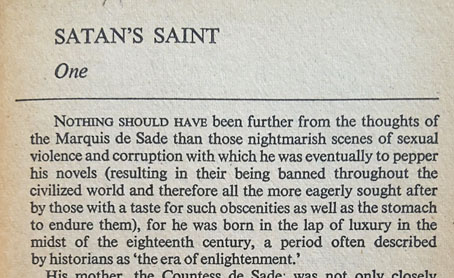
Previously on { feuilleton }
• The Execution of the Testament of the Marquis de Sade by Jean Benoît
• The Marat/Sade
• Surrealist cartomancy

In the final vignette of L’Age d’Or (1930), the surrealist film directed by Luis Buñuel and written by Buñuel and Salvador Dalí, the intertitle narration tells of an orgy of 120 days of depraved acts – a reference to De Sade’s “The 120 Days of Sodom” -and tells us that the survivors of the orgy are ready to emerge.
From the door of the castle emerges the Duc de Blangis, who is supposed to look like Christ. When a young girl runs out of the castle, the Duc comforts the girl, but then escorts her back inside. A loud scream is then heard and he reemerges with blood on his robes and missing his beard.
In 1975, Pier Paolo Pasolini turned the book into a film, Salò, or the 120 Days of Sodom. The film is transposed from 18th-century France to the last days of Benito Mussolini’s regime in the Republic of Salò. Salò is commonly listed among the most controversial films ever made. Criterion did a wonderful print with all the trimmings.
https://m.youtube.com/watch?v=PNF3Apf93UA
Ah, yes, both those films are very familiar, in fact I watched L’Age d’Or again recently. I laughed aloud when I first saw a weary Christ emerge at the end of the film. As for Salò, I have two copies on blu-ray, having bought it the once then ending up with it again when I got the BFI box of Pasolini films. It used to be so difficult to see that it feels strange now to have easy access to a pristine, restored and annotated print. The first copy I saw was a VHS tape that had been duplicated so many times it was almost unwatchable. The pictorial degradation made the cinematic degradation seem even more like a historical snuff movie.